
The “Second Aerial Gateway” to the Miyako region officially opens with the Miyako Shimojishima Airport Terminal
March 30, 2019 Ryukyu Shimpo
Miyako – The Miyako Shimojishima Airport Terminal officially opened at 8:00 a.m. on March 30. With the opening, the “second aerial gateway” to the Miyako region will begin operating in earnest. The terminal had an opening ceremony as well as a Miyako Shimojishima launch ceremony for, the Low-Cost Carrier JetStar, with countless people from Okinawa and the city of Miyakojima in attendance.
At the opening ceremony, Mayor Toshihiko Shimoji said in his opening remarks, “People from all over will arrive and depart from here, and it will lead to further interactions with people from abroad. I expect this to become a new aerial gateway.” Kentaro Tomono, CEO of Shimojishima Airport Management Co. Ltd (SAMCO), who operates the airport, said, “Finally, the starting day has arrived. We will devote ourselves so that more and more people can use the airport, and we want to progress each day in contributing to stimulating tourism in Miyakoshima and Okinawa.”
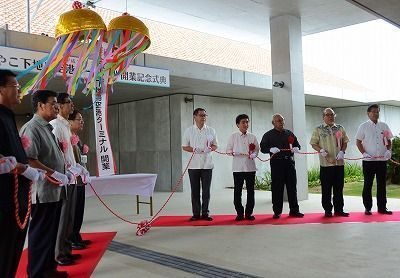
People involved with the airport celebrating at the opening ceremony
Next, at the launch ceremony for JetStar, CEO Masaru Kataoka reported smiling “The first voyage from Narita to Miyako Shimojishima was almost full in both directions. I think we can cultivate new demand and bring many people to visit Miyako.”
Shimojishima Airport has a 3,000 meter-long runway, and was first developed in 1979 as a training ground for pilots. In1980, there was a route that opened up between Naha and Shimojishima, however it was suspended in 1994. Thereafter, the number of training flights began to decline, and the airport became dormant. In order to find a use for the airport, Okinawa Prefecture began to court private businesses, and Mitsubishi Estate (Junichi Yoshida, President) signed an agreement in March of 2017, and began constructing a new terminal.

Passengers being greeted by the Miyakoshima Tourism Committee after disembarking from the airport’s first arrival.
The inaugural JetStar flight from Narita International Airport touched down at 10:55 a.m. At the arrival gate, there were representatives from the Miyakoshima Tourism Committee and JetStar applauding and playing the sanshin, giving a warm welcome to the passengers. The passengers had surprised and happy expressions as they passed through the arrival gate. Then, the return flight bound for Narita was boarded by passengers including Mayor Shimoji, and they were seen off by airport staff at noon.
In addition to the regular route run by JetStar Japan between Narita and Shimojishima, the same company has plans to start a route between Kansai International Airport and Shimojishima July 3 this year, and a Hong Kong-based LCC, Hong Kong Express, will launch a route to and from Hong Kong July 19. Additionally, the major Korean airline, Korean Air, plans to start using the airport for chartered flights in June.
(English translation by T&CT and Sam Grieb)
Go to Japanese

April 1, 2019 Ryukyu Shimpo online edition
Just past 1:55 p.m. on April 1, an MV-22 Osprey vertical takeoff and landing aircraft from Marine Corps Air Station Futenma made an emergency landing at Osaka International (Itami) Airport in Osaka Prefecture. There was no damage to the fuselage, and the aircraft drove off the runway and onto the parking apron.
Around 2:30 p.m. the Okinawa Defense Bureau (ODB) conveyed this news to the Okinawa prefectural government. The ODB explained, “We are in communication with the U.S. for further details.”
On March 27 another Osprey from MCAS Futenma made an emergency landing at Okinoerabu Airport in Kagoshima Prefecture. This model of aircraft continues to experience trouble in Okinawa, such as in December 2016 when an Osprey crashed on the shore in Abu, Nago City.
(English translation by T&CT and Erin Jones)
Go to Japanese

March 28, 2019 Ryukyu Shimpo
By Ayako Sakaguchi
Before Camp Schwab was completed there was a large pine tree on Cape Henoko. Takenobu Shimabukuro, 82, who loves photography, has been capturing photographs of his hometown since he was in his 20’s.
His albums are full of old black-and-white photographs. Soil deposits as part of Futenma Replacement Facility (FRF) construction in Henoko, Nago City, are ongoing.
Nowadays the landscapes that have been lost can no longer be seen, and are only kept alive in photographs.
Shimabukuro started photographing his hometown in the 1950’s.
When Camp Schwab was being built he worked as a surveyor.
Henoko was originally an isolated corner of land. In those days there was nothing to eat there.

The photograph was taken in the 1950’s in what was then Henoko, Kushi Village (currently Nago City). (Photograph courtesy of Takenobu Shimabukuro)
Residents would take winding routes into the mountains to barter for food, such as vegetables and rice.
Once the building of Camp Schwab began, construction workers came from all over the island and the population of Henoko grew.
Shimabukuro said, “It was beyond a [population] increase.
I didn’t like it. Naturally, many people rented out their homes.
People lived crammed close together.” Businesses like movie theaters and banks popped up in the settlement of Henoko, in which there were two bus stops.
Life became abundant compared with the era of selling firewood. Shimabukuro went on, “Since there were many jobs, many people came and crowded in.”
A bar district popped up in Henoko, along with over 100 restaurants to accommodate U.S. servicemen. Shimabukuro worked at a dance hall after the completion of Camp Schwab.
He thought back and said, “At that time there were too many foreign people for us to attend to.
Even so, it was fun.”
Although Henoko Ward is thought to have wanted the construction of Camp Schwab back then, Shimabukuro does not think it did.
His words were, “I don’t think [Henoko Ward] would have wanted it.
At that time the U.S. military was building a variety of bases.”
However, even now there are few people in Henoko who repudiate Camp Schwab.
The Camp put Henoko on the map and made it into a bustling community.
In reality, Henoko’s residents also work at restaurants in the Camp and Henoko proper, and Camp Schwab is in the details of Henoko residents’ daily lives.
Even so, Shimabukuro is anxious about the future. Specifically, he is anxious about construction of the FRF in Henoko, and soil deposits moving forward.
Shimabukuro has four sons, and three of the sons’ families no longer live in Henoko.
He explained, “It is noisy here now, so they will not live in Henoko. Truthfully, I would prefer everyone lived nearby.”
It is unknown how life in Henoko will be once the FRF is built.
Shimabukuro said, “I cannot sleep because it is noisy, it would be better if it was quiet.
There was nothing here in those times, but natural living was good. It isn’t clear how many decades it will take [for FRF construction to finish].”
The scenery of Henoko in old photographs lives on in Shimabukuro’s heart.
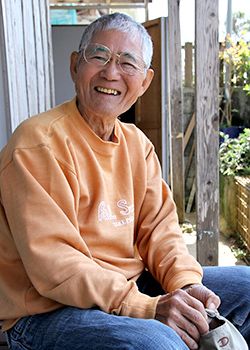
Takenobu Shimabukuro
(English translation by T&CT and Erin Jones)
Go To Japanese
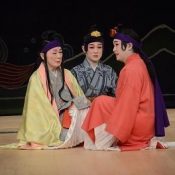
March 22, 2019 Ryukyu Shimpo Digital Edition
On March 22, the Japan Art Academy (director: Senji Kuroi) announced eight recipients of the 2018 Japan Art Academy Prize to honor talented artists.
One of the recipients was the Okinawan Kumiodori performer Noho Miyagi, 80, of Yonabaru, who is designated a Living National Treasure.
It was the first time an Okinawan has received the award. Noho Miyagi was lauded for his “performative expression through masterful technique in Kumiodori and accomplishment in contributing to increased accession by young performers.
” The award ceremony will be held at the end of June at the Japan Art Academy in Tokyo.
“I don’t know that I’m worthy, but I am truly honored.
It is all thanks to my predecessors who toiled to pass down the performative tradition over the generations.
I want to continue endeavoring to train young talent,” said Noho Miyagi.
Noho Miyagi’s “achievement of a performance style which boasts the elegant beauty of the female role and the grace unique to the Okinawan performing tradition, and in which strength is beautifully hidden within delicateness” and his “dedicated efforts to cultivate young talent” were given by the Japan Art Academy as reasons for his selection.
Noho Miyagi was born in 1938 in former Sashiki Village, now Nanjo City. His birth name is Masakichi Tokumura.
He studied under Nozo Miyagi, the founder of his school of performance. He became a professor at the Okinawa Prefectural University of Arts in 1990, and took the title of visiting professor in 2004 and of professor emeritus in 2007.
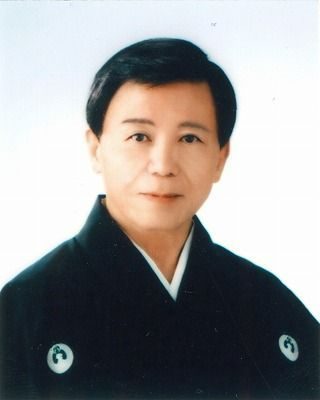
Noho Miyagi
He has been the head instructor of Kumiodori at the National Theater Okinawa since 2005. In 2006, he was designated a champion of the Important Intangible Cultural Property “Kumiodori performer” (individual designation)– a Living National Treasure.
In 2009, he was designated a champion of the Important Intangible Cultural Property “Ryukyu dance” (group designation).
He has been director of the Ryukyu Dance Preservation Association since 2015. He was awarded the Ryukyu Shimpo Award in 2013.
He is head of the Miyagi Honryu Ohtori no Kai school of dance.
(English translation by T&CT and Sandi Aritza)
Go To Japanese
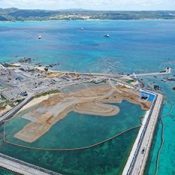
March 27, 2019 Ryukyu Shimpo
On March 25 at a plenary session of the Iwate Prefectural Assembly, the ruling coalition including the Social Democratic Party and the Japanese Communist Party adopted by majority vote a written statement titled “Request that land reclamation work in Henoko cease, and that Okinawa Prefecture be negotiated with in good faith, based on the results of the Okinawa prefectural referendum.” The opposition Liberal Democratic Party and the neutral Komeito Party opposed the statement.
This appears to be the first time that a prefectural assembly of Japan, excepting the Okinawa Prefectural Assembly, has adopted a statement requesting that construction of the new base in Henoko be stopped.
The statement points out that regarding land reclamation work in Henoko, “Due to the detection of matters including the existence of soft ground and an active fault line in the ocean area for land reclamation, the permit for land reclamation has been revoked, and the feasibility [of the land reclamation plan] is greatly shaken.
” Furthermore, the statement mentions, “The prefectural referendum not only clearly demonstrates Okinawan citizens’ opposition to land reclamation, it seeks earnest treatment based on regional autonomy, democracy, sovereignty of the people, and fundamental human rights as guaranteed by the Constitution.”
According to the Iwate Prefectural Assembly office, citizens groups such as the Cooperative Center against Constitutional Revision submitted the statement to the office. The statement is addressed to the Prime Minister, the Minister for Foreign Affairs, and others.
Iwate Governor Takuya Tasso spoke at a press conference on February 28 in regard to the next United States-South Korea Summit Conference.
He stated his opinion that relocating Futenma Air Station to Henoko is not essential in terms of reducing tensions in East Asia. Concerning the results of the Okinawa prefectural referendum, Governor Tasso said, “It is my personal opinion that [the results] should be taken seriously.
” This is the first time the governor of a prefecture other than Okinawa has made reference to the Okinawa prefectural referendum results.
(English translation by T&CT and Erin Jones)
Go To Japanese
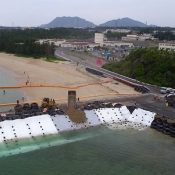
March 25, 2019 Ryukyu Shimpo online edition
On March 25 at 2:58 p.m. the Okinawa Defense Bureau (ODB) began initial soil deposits into a land reclamation section on the Henoko side of Cape Henoko, as part of construction of the Futenma Replacement Facility (FRF) in Henoko, Nago City.
Following the February prefectural referendum, which recorded over 70 percent local opposition to land reclamation work, the ODB has undertaken work on a new land reclamation section.
Citizens protested on the ocean and in front of gates to Camp Schwab, raising their voices against construction of the FRF.
At this time, soil deposits have started in land reclamation section 2 (measuring approximately 33 hectares), which is separate from land reclamation section 2-1 where soil depositing work is ongoing.
Just past 8:30 a.m. on March 25, the ODB notified the Okinawa Prefectural Seashore Disaster Prevention Division by phone, “As preparations are in order, we are starting land reclamation.”
In the morning on March 25 preparations for soil deposits at the site took place, including the setting up of silt curtains and the moving of heavy equipment.
Shortly prior, on March 16, a prefectural rally calling for the abandonment of construction of the FRF in Henoko was held at Shintoshin Park in Naha City. According to the organizers 10,000 people participated in the rally.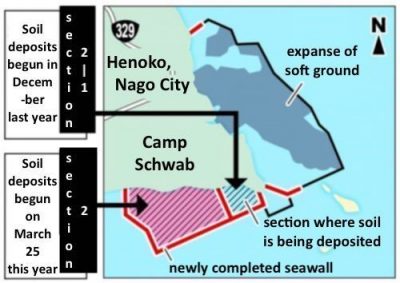
The central government is forcing land reclamation work through even after the results of the prefectural referendum have been made public, which is intensifying local opposition to the central government. When Okinawa Governor Denny Tamaki had a discussion with Prime Minister Shinzo Abe, Governor Tamaki requested that land reclamation be suspended. However, the central government conveyed its aim to begin soil deposits on March 25, as planned.
Initially, the progress schedule set land reclamation work to start in section 1 in Oura Bay. In December last year the plan was altered and soil deposits were started in section 2-1 on the Henoko side of Cape Henoko.
The plan was altered due to the discovery of an expanse of soft ground underwater on the Oura Bay side of Cape Henoko, making ground reinforcement work essential to the construction process. On the Oura Bay side, there appears to be no prospect for construction of the seawalls, the step prior to soil deposits, and none of these construction plans have been made public.
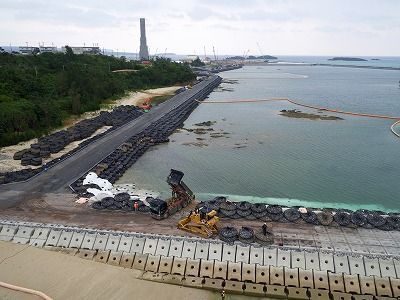
On March 25 at 3:11 p.m. on the shore of Camp Schwab, a truck unloads soil into land reclamation section 2 on the Henoko side. (Photograph taken via small drone)
(English translation by T&CT and Erin Jones)
Go to Japanese
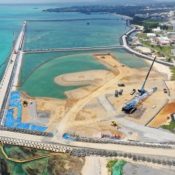
March 23, 2019 Ryukyu Shimpo
Okinawa Prefecture has filed a lawsuit against Japan March 22 at the Fukuoka High Court Naha Branch naming as defendant Minister of Land, Infrastructure, Transport, and Tourism (MLIT) Keiichi Ishii, demanding he overturn his injunction ending the efficacy of Okinawa’s revocation of Japan’s permission to for land reclamation work, part of the new base construction for the relocation of MCAS Futenma.
The prefectural government announced the comments given by Okinawa governor Denny Tamaki, who is currently in Hawaii on official business, explaining that the lawsuit was filed in response to the Japanese government informing them that they would begin land reclamation in a new area as planned starting March 25.
Governor Tamaki said, “We are putting all of our effort to overturn the MLIT’s injunction, which is the authority the Ministry of Defense (MoD) is leaning on to continue construction.”
This is the first time the governor has filed suit again Japan since taking office, once again putting the issues surrounding the new base construction at Henoko in the spotlight.
In the lawsuit, the points of contention will be the legality of both the Okinawa Defense Bureau’s (ODB) use of the Administrative Appeal process, as well as the MLIT’s injunction.
While Okinawa and Japan face of on yet another new lawsuit, a case at Japan’s top that has been ongoing since the tenure of Okinawa’s previous governor, Takeshi Onaga, that demanded construction be suspended due to the destruction of reefs by the government, Tamaki’s decision to withdraw the appeal to the top court is unchanged, and they are still preparing to withdraw the appeal shortly.
In August of 2018, Okinawa prefecture revoked the permission for land reclamation activity given during the gubernatorial administration of Hirokazu Nakaima, at which point the legal foundation for new base construction was lost, and construction stopped.
After this, the ODB used Japan’s Administrative Appeal process to request an injunction on the efficacy of Okinawa’s revocation. In October of 2018, the MILT decided to issue the injunction, and the ODB restarted construction.
Okinawa Prefecture argued that the injunction issued by the MILT was “illegal involvement by the national government,” and submitted an application for a ruling from the Committee for Settling National-Local Disputes, however last month the Committee ruled that the decision by the MILT did not constitute “national government involvement,” and rejected Okinawa’s request. The deadline of March 22 for Okinawa to file a lawsuit was quickly approaching.
In Governor Tamaki’s comments announced March 22, based on the results of the prefectural referendum as well as the Okinawan anti-base demonstration the governor demanded that construction and land reclamation be halted in his meeting with Prime Minister Shinzo Abe March 19.
However the following day the government answered that it would not honor their request, an answer Tamaki criticized saying, “The government’s behavior is deplorable.” Meanwhile, he stressed that conversations were still ongoing in the search for a resolution.
In the lawsuit, Okinawa indicated that the process used by the national government to overturn their retraction did not meet the requirements outlined in the Administrative Appeal Act.
(English translation by T&CT and Sam Grieb)
Go to Japanese

March 26, 2019 Ryukyu Shimpo
Shinya Yamanaka, recipient of the Nobel Peace Prize in Physiology or Medicine, and director of Kyoto University’s Center for IPS Cell Research and Application, gave a talk at the Ryukyu Shimpo Hall in Naha city on March 25.
Yamanaka used simple words to speak about his journey in medical research—which opened up a new frontier in medicine, and shared latest developments in his field.
He said to the auditorium full of young people, “I was absorbed in my research,” and encouraged them to “find what you love.”
The lecture was hosted as part of “Science driven prefectural development: Spread your wings abroad! Future scientists and Nobel laureates from Okinawa,” a joint project between the Ryukyu Shimpo and OIST (Okinawa Institute of Science and Technology Graduate University) to train the next generation of talents.
Yamanaka lost his father to a condition which was untreatable at the time.
His loss motivated him to pursue medical research in order to “cure patients with conditions are presently incurable.”
However, there are days this vision gets lost in the hustle and bustle of daily life.
The Nobel laureate shared his former professor’s mantra with the audience: “Work hard toward your Vision,” or “VW” for short. He said, “when I think of those words, I often find the path I need to take.”
He spoke on the importance of maintaining a vision and said, “I’m reaffirming this mantra myself as I share it with you.”
(English translation by T&CT and Monica Shingaki)
Go to Japanese
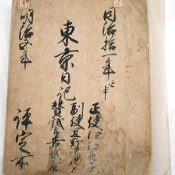
March 21, 2019 Ryukyu Shimpo
On March 18, Japan’s Council for Cultural Affairs submitted a report to the Minister of Education, Culture, Spots, Science and Technology Masahiko Shibayama.
The report recommends that “The 41 Materials and Documents Related to the Sho Royal Family of the Ryukyu Kingdom and Document Box” should be designated as national treasures.
The said items are currently in the possession of Naha City, Okinawa Prefecture. They are expected to be officially designated as national treasures this summer.
Naha Mayor Mikiko Shiroma made an announcement about this on March 20.
Among the documents that are to be designated as national treasures is the business log by the envoy group dispatched by Ryukyu to the new government following the Meiji Restoration.
The dispatching of the envoy group eventually led to the Disposition of Ryukyu or the forced assimilation of Okinawa into Japan.
In 2006, 85 works of art and 1,166 documents related to the Sho royal family were designated as national treasures from Okinawa for the first time since the end of the war.
Which means that the total number of documents related to the Sho royal family designated as national treasures will be 1,207 once the abovementioned items are added.
The 38 documents and document box that are to become national treasures were donated to Naha City in August 2018 by Mamoru Sho, the 23rd head of the Sho family.
The remaining three documents were transferred in December 2018 from the Ishigaki City Yaeyama Museum to Naha City.
A representative of the Naha City Cultural Properties Division said, “Like the other documents that have already been designated (as national treasures,) these documents are vital in understanding how the Ryukyu royal government operated.”
Naha City to Shed Light on the Disposition of Ryukyu
Among the Sho royal family documents are the “Tokyo Diary” and records listing the clothes worn by the king during New Year ceremonies.
Experts hope these documents will reveal the details of the duties and operations of the Ryukyu royal government.
Naha City is to restore and begin deciphering documents.
The envoy group that appears to have written the “Tokyo Diary” were dispatched to Tokyo to celebrate the establishment of the Meiji Government under the Emperor’s orders.
But in actuality, they had received a “pseudo document bestowing peerage” in which the Emperor recognized Ryukyu King Sho Tai as the “Ryukyu Domain Lord.”
It is said that this was the beginning of the Disposition of Ryukyu.
On the cover of the log lists the names Prince Ie and Ginowan Ueekata, who had been dispatched.
University of the Ryukyus Emeritus Professor Kikou Nishizato who looked at the cover of the “Tokyo Diary” pointed out that the secretary of the document may be a different secretary compared to a similar resource that has already been designated as a national treasure.
Kikou Nishizato specializes in Chinese-Ryukyu-Japanese relations.
He said, “This is likely to become an important historical resource to understand the details of the envoy group movements and the Ryukyu royal government’s response.
I’d like to hurry up and take a look at the contents.”
The 38 documents and document box that are to be designated as national treasures had been stored at Hiroshi Matsumoto’s house in Tokyo.
Hiroshi Matsumoto is the son-in-law of Hiroshi Sho, the 22nd head of the Sho Family.
Part of the Sho Family documents are already on display at the Naha City Museum of History and will remain on display while occasionally changing the content.
Additionally, the resources related to the Ie Udun Family, which is to be designated as an important cultural property, was put on display starting March 22.
(English translation by T&CT and Chelsea Ashimine)
Go to Japanese
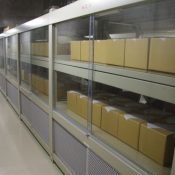
March 21, 2019 Ryukyu Shimpo
The remains of 63 Okinawans taken from the island by an Imperial University anthropologist in the early Showa era, were finally returned to Okinawa March 20 from the National Taiwan University, where they were being held.
According to the Okinawa Board of Education (BoE), who received the remains, the remains are being kept at the Okinawa Archaeological Foundation Center.
The BoE say that the remains are being preserved as historical data, and they are “currently examining,” the possibility on doing analysis of the remains.
There are currently no plans to display the remains for the general public.
The returned remains appear to contain the remains that were excavated from the Mumujana tomb in Nakijin for research purposes by Takeo Kanaseki in 1929.
Yasukatsu Matsushima (Ryukoku University), a representative for the Ryukyu Ancestral Remains Return Committee, has indicated that since the remains were excavated without the understanding of the descendants the action was illegal, and says that in order to restore dignity to the remains they must be re-entombed at their original burial site.
However, the BoE representatives have stated, “We have not yet given thought to re-entombing the remains.”
The remains were sent from Taiwan with each remain packaged in its own cardboard box, and they landed in Okinawa on March 18.
Currently, the remains are being stored at the Okinawa Archaeological Foundation Center in the boxes in which they were sent.
The BoE is looking into moving the remains into wooden boxes, as well as trying to determine the appropriate climate conditions for preserving the remains.
A representative from the BoE said, “Since they only just arrived, first we want to make sure they are properly preserved.”
In addition to Taiwan, some of the remains excavated from various locations in Okinawa by Kanaseki are also being stored at Kyoto University.
Since it is unclear whether or not Kyoto University will return the remains, last year in December researchers filed a lawsuit in Kyoto demanding the return of the remains.
Remains excavated for research purposes are now being returned one after the other from universities and museums all over the world.
Even domestically, Ainu remains kept in places such as Hokkaido University are being returned.
(English translation by T&CT and Sam Grieb)

















 Webcam(Kokusai Street)
Webcam(Kokusai Street)


